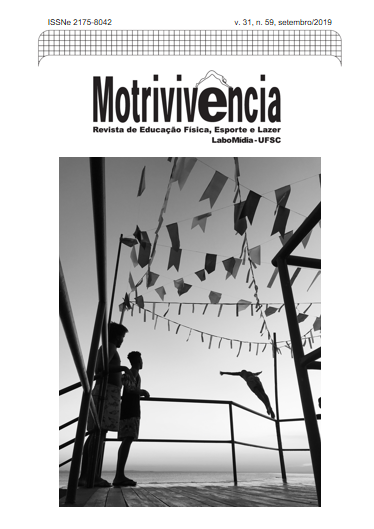Effect of physical exercise on gait kinematics in people with down syndrome - systematic review
DOI:
https://doi.org/10.5007/2175-8042.2019e57043Abstract
People with Down syndrome (SD) present gait problems from childhood to adulthood. Objective of this study was to perform a systematic review of the literature addressing the effect of controlled physical exercise on gait kinematics in SD individuals. The literature search occurred in eight electronic databases. Quality analysis (k = 0.92) of ten studies was selected and verified. Thus, there was a lack of research on the effects of controlled training programs on gait kinematics in the syndromic population. There was a greater participation of males (37%) compared to females (27.3%), and 60% of the studies aimed at the syndromic population in this study concern infants with aerobic training protocols. The results showed benefits of controlled exercise programs modifying favorably the kinematics of gait of individuals with DS, especially in the first two years of life.
References
ANGULO-BARROSO, RM.; WU, J.; ULRICH, DA. Long-term effect of different treadmill interventions on gait development in new walkers with Down syndrome. Gait Posture. v. 27, p. 231–238, 2008.
COPETTI, F.; MOTA, CB.; GRAUP, S.; MENEZES, KM.; VENTURINI, EB. Comportamento Angular do andar de crianças com Síndrome de Down após intervenção com Equoterapia. Rev. bras. fisioter. v. 11, n. 6, p. 503-507, 2007.
GALLI, M.; RIGOLDI, C.; MAINARDI, L.; TENORE, N.; ONORATI, P.; ALBERTINI, G. Postural control in patients with Down syndrome. Disability and Rehabilitation. v. 30(17), p. 1274 – 1278, 2008.
GRAUP, S.; OLIVEIRA, RM.; LINK, DM.; COPETTI, F.; MOTA, CB. Efeito da Equoterapia sobre o padrão motor da marcha em crianças com síndrome de Down: uma análise biomecânica. Efdeportes Revista Digital. Buenos Aires, v. 96, p. 1-10, 2007 Disponível em: http://www.efdeportes.com/efd96/equot.htm. Acesso: em Dez. 2017.
HALLEMANS, A.; DECLERCQ, D.; AERTS P. Changes in 3D joint dynamics during the first 5 months after the onset of independent walking: a longitudinal follow-up study. Gait Posture. v. 24, p. 270–279, 2006.
HALLEMANS, A.; DECLERCQ, D.; OTTEN, B.; AERTS P. 3D joint dynamics of walking in toddlers: a cross-sectional study spanning the first rapid development phase of walking. Gait Posture. v. 22, p. 107–118, 2005.
LIN, HC.; WUANG, YP. Strength and agility training in adolescents with Down syndrome: A randomized controlled trial. Research in Developmental Disabilities. v. 33, p. 2236–2244, 2012.
LOOPER, J.; WU, J.; ANGULO-BARROSO, RM.; ULRICH, DA.; ULRICH, BD. Changes in foot placement variability in newly walking toddlers with typical development and with Down syndrome. J Mot Behav. v. 38, p. 367–372, 2006.
MAHY, J.; SHIELDS, N.; TAYLOR, NF.; DODD, KJ. Identifying facilitators and barriers to physical activity for adults with Down syndrome. J Intellect Disabil Res. v. 54, n.9, p. 795-805, 2010.
MARCHEWKA, M.; CHWALA, W. The effect of rehabilitation exercises on the gait in people with Down syndrome. Biology of Sport. v. 25, n 4, p. 339-350 (12), 2008.
PALISANO, RJ.; STEPHEN, WD.; RUSSELL, DJ.; ROSENBAUM, PL.; GEMUS, B.; GALUPPI, BE.; CUNNINGHAM, L. Gross Motor Function of Children With Down Syndrome: Creation of Motor Growth Curves. Arch Phys Med Rehabil, v. 82, p. 494-500, 2001.
POLASTRI, PF.; BARELA, JA. Perception-action coupling in infants with Down syndrome: effects of experience and pratice. Adapt Phys Activ Q. v. 22(1), p. 39-58, 2005.
RIGOLDI, C.; GALLI, M.; ALBERTINI, G. Gait development during lifespan in subjects with Down syndrome. Research in Developmental Disabilities. v. 32, p. 158–163, 2011.
RIMMER, JH.; HELLER, T.; WANG, E.; VALERIO, I. Improvements in physical fitness in adults with Down syndrome. Am J Ment Retard. v. 109, p. 165–174, 2004.
SMART, NA.; WALDRON, M.; ISMAIL, H.; GIALLAURIA, F.; VIGORITO, C.;
CORNELISSEN, V.; DIEBERG, G. Validation of a new tool for the assessment of study quality and reporting in exercise training studies: TESTEX. Int J Evid Based Healthc. v. 13: p. 9–18, 2015.
SMITH, BA.; KUBO, M.; BLACK, DP.; HOLT, KG.; ULRICH, BD. Effect of practice on a novel task--walking on a treadmill: Preadolescents with and without Down syndrome. Phys Ther. v. 87, p. 766–777, 2007.
SZYMANSKA, AJ.; MIKOLAJCZYK, E.; WOJTANOWSKI, W. The effect of physical training on static balance in young people with intellectual disability. Research in Developmental Disabilities. v. 33, p. 675–681, 2012.
ULRICH, DA.; LLOYD, MC.; TIERMAN, CW. Effects of intensity of treadmill training on developmental outcomes and stepping in infants with Down syndrome. Phys Ther. v. 88, p. 114–122, 2008.
WUANG, YP.; SU, CY. Patterns of participation and enjoyment in adolescents with Down syndrome. Research in Developmental Disabilities. v.33, p.841–848, 2012.
WU, J.; LOOPER, J.; ULRICH, DA.; ULRICH, R.; ANGULO-BARROSO, M. Exploring effects of different treadmill interventions on walking onset and gait patterns in infants with Down syndrome. Dev Med Child Neurol. v. 49, p. 839–945, 2007.
WU, J.; LOOPER, J.; ULRICH, DA.; ULRICH, R. Strategy adoption and locomotor adjustment in obstacle clearance of newly walking toddlers with Down syndrome after different treadmill interventions. Exp Brain Res. v. 186, p. 261–272, 2008.
WU, J.; LOOPER, J.; ULRICH, DA.; ULRICH, R.; ANGULO-BARROSO, M. Effects of various treadmill Interventions on the development of joint kinematics in infants with Down Syndrome. Physical Therapy. v 90, p. 1265-1276, 2010.
WU, J.; BEERSE, W.; LIANG, TA. Walking Dynamics in Preadolescents With and Without Down Syndrome. Physical Therapy. v. 95, n5, p. 740-749, 2015.
Downloads
Published
How to Cite
Issue
Section
License
Os autores dos textos enviados à Motrivivência deverão garantir, em formulário próprio no processo de submissão:
a) serem os únicos titulares dos direitos autorais dos artigos,
b) que não está sendo avaliado por outro(s) periódico(s),
c) e que, caso aprovado, transferem para a revista tais direitos, sem reservas, para publicação no formato on line.
Obs.: para os textos publicados, a revista Motrivivência adota a licença Creative Commons “Atribuição - Não Comercial - Compartilhar Igual 4.0 Internacional” (CC BY-NC-SA).



